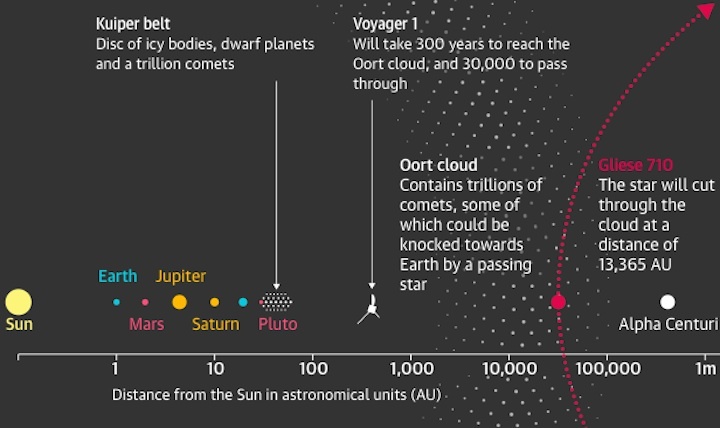The collision of a giant comet with the Earth is one of the most violent and cataclysmic events that could befall our planet. It has happened in the past, but the odds of another such catastrophe have remained uncertain.
Now astronomers have performed the cosmic equivalent of a risk assessment. A new paper calculates how often stars stray into the Oort cloud, a vast, spherical shell of billions of icy objects that is thought to envelop our solar system. Such close encounters can dislodge these loosely orbiting comets, sending them hurtling into the solar system, risking a collision course with the Earth.
Within the next million years, the paper predicts, between 19 and 24 stars will come within 3.26 light years of the sun – sufficiently close to deflect comets markedly from their original paths.
“Certainly anything coming within that distance you should worry about,” said Coryn Bailer-Jones, of the Max Planck Institute for Astronomy in Heidelberg and the paper’s author.
Not all close encounters would lead to comets hitting the Earth – this would depend on a mixture of luck and on where the Earth is in its orbit relative to the passing star – but the chances of a collision would peak at these time points.

A further 490 to 600 stars will pass the sun within a distance of 16.3 light years within the next million years, the paper estimates. This is far beyond the predicted outer reaches of the Oort cloud, but in the case of a very large star, still potentially close enough to cause comets to swerve in their tracks.
The Oort cloud has never been observed directly, but scientists have inferred its existence because the comets we see in the night sky would have disintegrated or sublimed long ago if they had always been in their current orbits. So scientists believe they must spend most of their existence in an outer reservoir and get kicked inwards by passing stars.
Theoretical models suggest the Oort cloud spans from as close as 2,000 astronomical units (1AU is the Earth-sun distance) to as far as 200,000 AU. There are likely to be billions of loosely orbiting comets, with sizes up to a few or even a few dozen kilometres. Given their great distance, these comets feel only a very slight pull of the sun’s gravity – just enough to keep them in orbit – and can be easily dislodged.
The latest calculations are based on data from the Gaia space telescope, which is mapping the positions and trajectories of about 1% of the Milky Way’s 200 to 300 billion stars.
Within the Milky Way’s disk, stars are orbiting about the galactic centre. Our sun completes one orbit in about 250m years, sometimes crossing the paths of other stars in brief stellar encounters.
The latest finding, published in the journal Astronomy & Astrophysics, suggests that these encounters occur about twice as frequently as previous estimates.

Previously, Gaia scientists revealed that the closest encounter on the horizon will be a dwarf star, Gleise 710, which will come within 16,000 AU in about 1.3m years. “Gaia found it’s going to come much closer than we thought. It’s quite exciting,” said Bailer-Jones. “But we’re going to have to wait more than a million years I’m afraid.”
In the future, astronomers are hoping to extend their search deep into the past in the hope of finding stars that might be ultimately responsible for the demise of the dinosaurs, 66m years ago.
Although it is not certain whether the impact that is thought to have caused this mass extinction was a comet or an asteroid, some speculate that a comet is more likely as these tend to be bigger and so more likely to have caused the most cataclysmic impacts.
“Potentially you could imagine tracing the orbit back 66 million years and identifying whether there was any star that came close to the sun and postulating whether that ejected a comet,” said Bailer-Jones. “That would be the holy grail.”
Quelle: theguardian

